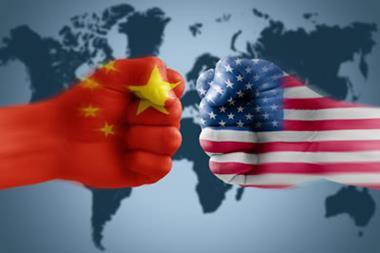As a manufacturing hub, the APAC region is a crucial cog in the global supply chain, but evidence suggests that business interruption is a concern. Here’s what risk managers need to know
In the wake of the largest business interruption event of the modern era – the COVID-19 pandemic – all signs suggest the thorny area of disrupted operations is a top risk for APAC businesses.
For UK and EU organisations, this should be ringing alarm bells, thanks to the high concentrations of suppliers in the region.

Labelled as ’Factory Asia’ by the Asian Development Bank, APAC’s is a central manufacturing hub between both Europe and the US making it an essential link in the global supply chain.
“In particular, South Korea, Japan and China play an important role in the global upstream supply chain,” says Ryan Du, senior team leader, Allianz Risk Consulting – Property, AGCS Asia Pacific.
”South Korea, Japan and China play an important role in the global upstream supply chain”
“For example, in the pharmaceutical industry, China and India are major producers of active pharmaceutical ingredients (API) and any BI at these API plants will cause major disruption in other parts of the world, especially in the US or Europe.”
Other APAC-specific examples include the electric vehicles (EV) sector, where China, South Korea and Japan account for a sizable share of global lithium battery production, and the electronics sector where East Asian and Southeast Asian economies account for over 60% of global production exports of electronic parts.
Understanding the threats
Despite the critical nature of APAC businesses to the global supply chain, the region is at risk of significant business interruption.
The common features of the Singapore and South Korea manufacturing sectors are that they are both high-value, very export-focused and dependent on external demand.
Jude Cross, regional manager, Allianz Risk Consulting Asia-Pacific at Allianz Global Corporate & Specialty (AGCS), explains: “Global supply chains and distribution are key to their success and hence these companies are very sensitive to supply chain disruptions, such as availability, delays or volatility in material or component prices.”
Hailee Jang, head of property at Allianz Global Corporate & Specialty (AGCS) South Korea, adds: “We see companies in South Korea focusing more on BI as compared to other key risks such as cyber or natural catastrophes, as BI cover is considered an essential – sometimes even mandatory – first layer of protection.
This is because the industry sector is dominated by heavy industries including automobile, steel, energy, chemical, EV battery and technology, which are more exposed to BI risks.”
“Bitter experiences like a number of massive and tragic natural catastrophe events in the APAC region have offered object lessons on the fragility and vulnerability of energy supply chains”
A big concern of businesses post-COVID is business interruption caused by events where physical loss or damage has not occurred. Another concern is obtaining enough BI cover following a cyber attack, as well as interruption due to a disruption with an insured’s customers or suppliers.
AXA XL’s head of property & casualty, marine, and aerospace-Asia, Todd Wilhelm, says: “Currently the market has not responded to these concerns due to the potential systemic risk across an insurer’s portfolio. ”A similar concern is shared within the casualty space via lack of interest in insuring pure financial loss.
“For BI caused by physical loss or damage, the cover can normally be found in the marketplace, but is it enough? That’s the challenge insureds have today.”
For almost every industry, an interruption to the business, be it manufacturing or services, is damaging or potentially fatal to the survival of the enterprise.
Bruce Gordon, global risk consulting leader, Asia Pacific, Commercial Risk Solutions, at Aon, says that risk is fungible and fluid, and the last three years has taught the broader community that simply sticking a label on a risk does not mean it will manifest in the manner anticipated.
He explains: “Bitter experiences like a number of massive and tragic natural catastrophe events in the APAC region have offered object lessons on the fragility and vulnerability of energy supply chains, as well as on insurance responses to ’business interruption’ in its literal/non-insurance sense.”
How to tackle supply chain business interruption exposure
COVID-19 has had a significant impact on how companies plan for BI.
AGCS’s Cross explains: “The thinking around supply chain management has shifted from cost and efficiency towards resilience and reliability.
“While companies all approach BI planning differently, there are some common solutions. First, develop alternatives and/or multiple suppliers. Here we have also seen companies starting to build up their inventory of raw materials and abandon the just-in-time approach.”
Another popular risk management strategy is broadening geographical diversification of supplier networks in response to geopolitical trends, with more regionalisation of supply chains.
”We have also seen companies starting to build up their inventory of raw materials and abandon the just-in-time approach”
For instance, the ’C +1’ model is increasingly common, where companies invest in another country, plus China, to diversify their business and better manage risks.
Cross says: “Countries such as Vietnam, Thailand, Malaysia and Indonesia are favourable investment destinations in Asia Pacific.
When approaching BI, companies also need to be mindful about the increasing complexities in the geopolitical environment, such as US-China relations, which can have extensive and profound effects on supply chains.”
To cope with the growing complexity, forward-thinking companies are initiating or improving business continuity management. This means placing more emphasis on stress-testing business continuity plans by conducting exercises based on different scenarios.
Of course, many businesses are still recovering from the massive supply chains and system shock that happened during the pandemic.
“We may also see a trend of businesses looking to the insurance market for alternative insurance solutions such as parametric products in respect of extreme weather events”
This led to shortages of raw materials and components, shipping delays, port blockages, even an under-supply of truck drivers.
WTW’s head of claims Asia, corporate risk & broking, Neil Thomas, says: “Supply chains could not adjust to huge fluctuations in consumer demand. This systemic challenge left contingency plans inoperable and has prompted businesses to rebuild their supply chains from the ground up.
”The experience has created a demand-bulge for relevant BI coverage.”
Gillian Davidson, partner, commercial insurance, at Sparke Helmore Lawyers in Sydney, adds. “We may also see a trend of businesses looking to the insurance market for alternative insurance solutions such as parametric products in respect of extreme weather events,”




















No comments yet